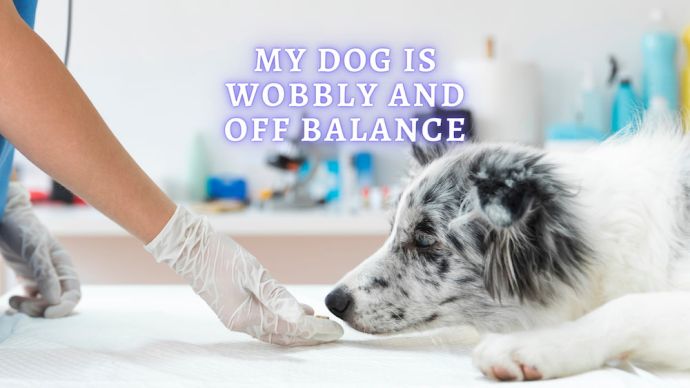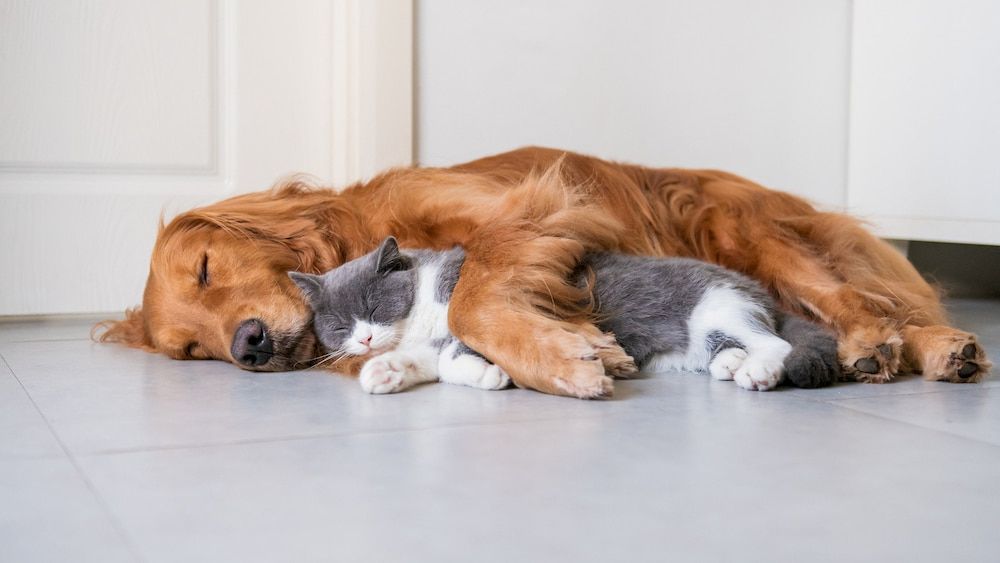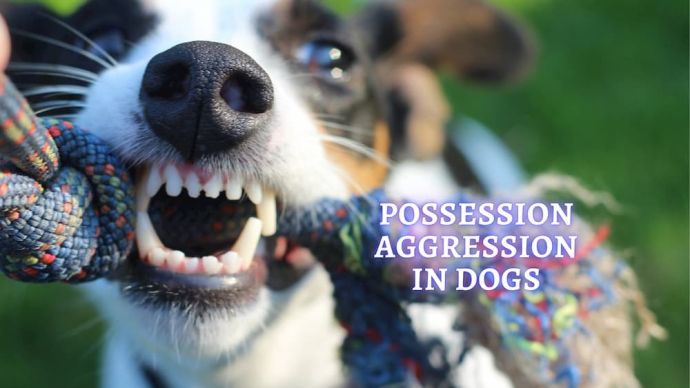How to Help Cats and Dogs Get Along? (Veterinary Advice)
Written by:
Author: Dr. Catherine Barnette
Dr. Barnette is a small animal veterinarian with 14 years of clinical experience in small animal general practice. She currently divides her time between part-time clinical practice and freelance writing, while also volunteering in her community. Her primary medical interests are preventive medicine and client education.
View all 3 articlesLearn about our editorial process and veterinary review board.
Viewed: 309
Updated on: 04/24/2023
If you’re an animal lover, there is a good chance that you may someday find yourself sharing your home with both dogs and cats. Unfortunately, this concept is often intimidating due to dogs’ friendly and sometimes-territorial nature combined with the more aloof nature of cats.
In some cases, we may even find ourselves asking whether cats and dogs can ever get along. The good news is that dogs and cats can learn to co-exist peacefully or even become friends. There are several steps you can take to help improve the relationship between your pets.
How should I introduce my Dog and Cat to each other?
The key to introducing pets is to do it slowly. Throwing two pets in a room together is rarely an effective strategy. Instead, consider the following step-by-step approach:
1. Introduce your pets to each other’s scents
Both animals rely heavily on the scent when getting acquainted with other animals. So while keeping your dog and cat physically separated (confined in separate rooms), allow them to smell each other’s belongings. First, allow your cat to smell the dog’s bed, toys, and other belongings. Then, let your dog smell your cat’s bed and belongings. This allows your pets to become familiar with each other’s smells.
2. Introduce your pets through a barrier
The easiest way to achieve this step is to have your pets on opposite sides of a closed door, although a crate can also be used if necessary. If you use a closed-door, make sure that there is a person on each side of the door so that each pet can be provided with reassurance and positive reinforcement. For example, allow your pets to sniff at each other under the closed door and hear each other’s sounds. Reward your pets with attention and treats for responding appropriately and without aggression.
3. Allow your pets to interact, while keeping your dog on a leash
Keeping your dog on a leash for your pets’ first true interaction gives you more control over the situation. Don’t force your cat to interact; if the cat runs away from the dog, use the leash to keep the dog from following. Over time, many cats will begin to show curiosity and come out of hiding to greet the dog from a safe distance.
4. Allow the pets free access to each other, but be sure that the cat has an escape route
When your pets are comfortable interacting with the dog on a leash, you can remove your dog’s leash. Ensure that there is an easy way for your cat to get away from another pet. For example, cats usually prefer to escape through climbing, so introduce your pets to a room where the cat can easily climb out of the dog’s reach. Also, stay nearby so that you can intervene as necessary.
At each step, wait for your dog and cat to have several positive interactions before moving onto the next level. Each step may take anywhere from an hour to several days, depending on your pets’ personalities. Therefore, it may take several weeks to work through all four steps. Once you have successfully done so, you can begin allowing your dog and cat to be loose in the house under your direct supervision. However, if you need to leave the room, it’s best to separate your pets (for at least the first few months) to minimize the risk of injury.
READ MORE: How to Introduce a Cat to a Dog?
How long does it take for a Cat to get used to a Dog?
In general, most cats will become acclimated to a puppy within several weeks. Some cats may adapt easily, within a matter of days, while others may take longer and require more focused or intentional effort.
The most important thing is to introduce your pets slowly and carefully. If you just throw them into a room together, there is a risk of injury. While you may be worried about your dog biting or otherwise injuring your cat, cats can also hurt dogs. Cats often use their claws when cornered and afraid; a scratch to the eye could cause a corneal injury, which would be painful and could even affect your dog’s vision if untreated.
Also, throwing your pets together can lead to stressful interactions that make it even more challenging to later acclimate your pets to each other. For example, if the first introduction between your dog and cat is an unpleasant one, they will be far less receptive to pleasant interactions in the future!
Take your time when working through the above steps to make the introduction as safe and low-stress as possible.
READ MORE: Signs your cat loves you
Can you train a Dog to be good with Cats?
If your dog has trouble acclimating to the presence of a cat, there are several training tips that you can use.
First, work with your dog on typical obedience commands, such as “sit” and “lay down”. Do this first in a quiet area, away from your cat, and where your dog is not distracted. Once your dog is reliably responding to these commands in a distraction-free environment, you can begin to utilize them when your cat is around. Your family friend can’t chase your cat while simultaneously sitting or laying down, so giving a command that is incompatible with chasing the cat can help.
Next, consider teaching “leave it” or another similar command. Again, begin by working on this skill in a quiet, distraction-free area. For example, offer your dog a toy or a less desirable treat. Then, say “leave it” while providing a tasty treat that is even more desirable than what you initially offered. Your dog will see the tasty treat and ignore the first item to receive the second.
At first, you should visibly offer the treat while giving the command but, over time, you can begin keeping the treat hidden from view until your dog actually walks away from the first item. Once your dog can reliably obey this command in a distraction-free environment, you can use this command to get your dog to leave the cat alone. But, again, be sure to use treats. “Leave it” should not be said as a punishment but instead should be presented as a game.
READ MORE: How to Keep Your Kitten Entertained
What do you do if your Cat and Dog don’t get along?
If you are currently dealing with a dog and cat that do not get along, review the above steps to determine whether you introduced them appropriately. If you realize that you may have rushed their introduction, separate the animals for a few weeks and then try to reintroduce them more gradually.
In some cases, you may need outside help. Creating a plan to help your pets get along requires careful consideration of your individual pets’ characteristics and your particular home environment. Talk to your veterinarian to see if they can help or give you a referral high-quality in-home trainer.
In general, this problem can be worked through. However, it’s essential to set realistic goals. For example, there may always be times that you need to keep your pets separated for their safety. Additionally, helping your pets get along will require a commitment from everyone in your household. With some effort, though, you should be able to achieve success.
READ MORE: Do Cats get bored
 Dog Care My Dog is Wobbly and Off Balance: What Should I Do? (Vet-Approved Advice)
Dog Care My Dog is Wobbly and Off Balance: What Should I Do? (Vet-Approved Advice) - 5748
- 0
 Dog Veterinary Tips Pneumonia in Dogs: Symptoms, Diagnosis, Treatment and Recovery (Vet Advice)
Dog Veterinary Tips Pneumonia in Dogs: Symptoms, Diagnosis, Treatment and Recovery (Vet Advice) - 478
- 0
 Cat Care Why Does My Cat Attack My Legs? 10 Reasons Why and What To Do About It (Vet-Approved Advice)
Cat Care Why Does My Cat Attack My Legs? 10 Reasons Why and What To Do About It (Vet-Approved Advice) - 46013
- 21
 Cat Veterinary Tips Cat Stomach Gurgling: Vet Advice on Why is Your Cat Stomach Gurgling?
Cat Veterinary Tips Cat Stomach Gurgling: Vet Advice on Why is Your Cat Stomach Gurgling? - 36469
- 4
 Cat Veterinary Tips My Cat Lost its Voice: Can Cats get Laryngitis? (Vet Advice)
Cat Veterinary Tips My Cat Lost its Voice: Can Cats get Laryngitis? (Vet Advice) - 23554
- 13
























